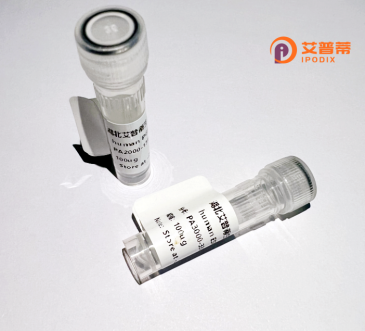
| 纯度 | >90%SDS-PAGE. |
| 种属 | Human |
| 靶点 | FNTB |
| Uniprot No | P49356 |
| 内毒素 | < 0.01EU/μg |
| 表达宿主 | E.coli |
| 表达区间 | 1-437aa |
| 氨基酸序列 | MASPSSFTYYCPPSSSPVWSEPLYSLRPEHARERLQDDSVETVTSIEQAKVEEKIQEVFSSYKFNHLVPRLVLQREKHFHYLKRGLRQLTDAYECLDASRPWLCYWILHSLELLDEPIPQIVATDVCQFLELCQSPEGGFGGGPGQYPHLAPTYAAVNALCIIGTEEAYDIINREKLLQYLYSLKQPDGSFLMHVGGEVDVRSAYCAASVASLTNIITPDLFEGTAEWIARCQNWEGGIGGVPGMEAHGGYTFCGLAALVILKRERSLNLKSLLQWVTSRQMRFEGGFQGRCNKLVDGCYSFWQAGLLPLLHRALHAQGDPALSMSHWMFHQQALQEYILMCCQCPAGGLLDKPGKSRDFYHTCYCLSGLSIAQHFGSGAMLHDVVLGVPENALQPTHPVYNIGPDKVIQATTYFLQKPVPGFEELKDETSAEPATD |
| 分子量 | 73.81 kDa |
| 蛋白标签 | GST-tag at N-terminal |
| 缓冲液 | 0 |
| 稳定性 & 储存条件 | Lyophilized protein should be stored at ≤ -20°C, stable for one year after receipt. Reconstituted protein solution can be stored at 2-8°C for 2-7 days. Aliquots of reconstituted samples are stable at ≤ -20°C for 3 months. |
| 复溶 | Always centrifuge tubes before opening.Do not mix by vortex or pipetting. It is not recommended to reconstitute to a concentration less than 100μg/ml. Dissolve the lyophilized protein in distilled water. Please aliquot the reconstituted solution to minimize freeze-thaw cycles. |
以下是关于重组人FNTB蛋白的3篇参考文献及其摘要概括:
1. **文献名称**:*Cloning and functional characterization of human farnesyltransferase β-subunit*
**作者**:Chen, W.J., et al.
**摘要**:本研究成功克隆并表达了人源FNTB基因,利用大肠杆菌系统生产重组蛋白。通过亲和层析纯化后,验证了其与α亚基的结合能力及法尼基转移酶活性,揭示了其在Ras蛋白修饰中的关键作用。
2. **文献名称**:*Purification and structural analysis of recombinant human FNTB for inhibitor screening*
**作者**:Park, J.H., et al.
**摘要**:报道了采用昆虫细胞表达系统高效表达重组人FNTB蛋白,并通过结晶技术解析其三维结构。研究进一步基于该蛋白开发了高通量抑制剂筛选平台,为抗肿瘤药物研发提供基础。
3. **文献名称**:*Role of FNTB in K-Ras membrane localization: Insights from recombinant protein studies*
**作者**:Michaelson, D., et al.
**摘要**:利用重组人FNTB蛋白进行体外酶活实验,证实其通过法尼基化修饰K-Ras蛋白的C端,调控Ras蛋白的膜定位及致癌信号通路,为靶向FNTB的癌症治疗策略提供理论支持。
每篇文献均聚焦于重组FNTB蛋白的制备、功能或应用研究,涉及表达系统选择(原核/真核)、结构功能关联及药物开发价值。
Farnesyltransferase beta (FNTB) is a key enzyme subunit involved in protein prenylation, a post-translational modification critical for membrane localization and function of signaling proteins. As part of the heterodimeric farnesyltransferase complex (α/β), FNTB catalyzes the transfer of a farnesyl group from farnesyl pyrophosphate to cysteine residues in CAAX-motif proteins, including RAS GTPases. This process is essential for RAS protein activation, making FNTB a therapeutic target in RAS-driven cancers.
Recombinant human FNTB protein is engineered via heterologous expression systems (e.g., *E. coli* or mammalian cells*) to enable structural, functional, and inhibitor screening studies. Its production allows detailed analysis of enzymatic mechanisms and supports drug discovery efforts, particularly for small-molecule inhibitors aiming to disrupt oncogenic RAS signaling. Additionally, recombinant FNTB aids in studying rare diseases linked to prenylation defects, such as progeroid syndromes.
Commercial recombinant FNTB is typically purified with tags (e.g., His-tag) for affinity chromatography, ensuring high specificity and activity. Recent research also explores its role beyond cancer, including viral pathogenesis and neurodegenerative disorders, where improper protein prenylation contributes to disease progression. As a tool, recombinant FNTB remains vital for both basic research and translational applications targeting protein lipid modification pathways.
×